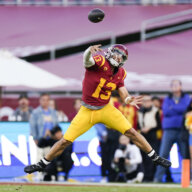The last time Merion Golf Club in Ardmore hosted the U.S. Open in 1981, Richard Ill drove a cart carrying participating players to and from the practice tees.
Ill, who recently served five years as the prestigious club’s president, wasn’t even a member during that tournament.
A lot has changed in three decades. When the country’s biggest tournament crowns a champion June 16, 2013, Ill will very likely be on the green helping present the trophy after serving as Merion’s tournament chairman.
“We did a lot of work to get it,” Ill said in interviews with Metro last week and during a short tour of the course yesterday. “The [USGA] really wanted to come back to an old, traditional golf course.”
The crown jewel of Philadelphia’s golf scene, which itself is steeped in history, has hosted the U.S. Open four times previously: 1934, 1950, 1971 and 1981. It has hosted a multitude of other national championships, including one of the most famous ever. Golfer Bobby Jones won the final leg of what was dubbed the “Grand Slam” in 1930 when he won the U.S. Amateur Championship at Merion.
An estimated 25,000 fans will descend on the course at 450 Ardmore Ave. each of the tournament’s four days next year. Then there’s the 5,000 volunteers who will help the U.S. Golf Association, including about 500 club members.
“In 1981, there were 500 volunteers. This year, we have 5,000,” Ill said, adding that preparation for the U.S. Open started more than two years ago and doesn’t end until the Monday before the tournament.
“We set up all our committees: on course operations, administrative services, financial services, hospitality committee. Since last September, we’ve had four usga operations people here and they have their own office,” he said. “It’s amazing the magnitude and the number of people and the infrastructure you need logistically. Another important committee was the off course logistical committee working with local politicans and township administration to get approval. We’ve worked with PECO and SEPTA and they’ve been very cooperative.”
Tune up was simple: Get longer
The problem with many of America’s best century-old courses: lack of space.
Some worried that the game, now dominated by courses over 7,000 yards because pros hit 300-plus yard drives and 200-yard five-irons, had left shorter courses like Merion in the past.
It normally plays slightly more than 6,500 yards, but the USGA and Merion members figured out during the past two years how to stretch out the course to 6,970 yards for the 2013 U.S. Open.
“It will be four par 4’s longer than 500 yards. But due to the fact we have no more land, we have some holes shorter than normal Opens,” Ill said.
Still, what will make Merion a true test is what any golfer will tell you is the most difficult aspect of the game: accuracy.
We will have narrow fairways. They will average about 22 to 24 yards wide,” Ill said.
A quick look at Merion Golf Club yesterday provided a glimpse into the mystique of the 100-year-old East course.
– The “Rock Quarry”: A steep wooden staircase into a valley of overgrown wasteland on the 250-yard par 3 17th hole gives perspective about just how daunting the ravine is on the second to last hole. It also provides the landscape for a knee-rattling, 150-yard forced carry to the 16th green.
– Wicker baskets: Merion’s most unique accessory are the baskets that are in place of flags on top of the sticks that mark each green’s hole. They harken to the course’s designer, Hugh Wilson, who came upon the idea in Scotland during his research for Merion’s design. The USGA agreed to keep them in place for the 2013 Open.
– High dunes: Sand traps don’t give tour pros much trouble these days, but that could be different next year. One of Merion’s most obvious obstacles are the very high, thick grasses lining the sand traps.





























